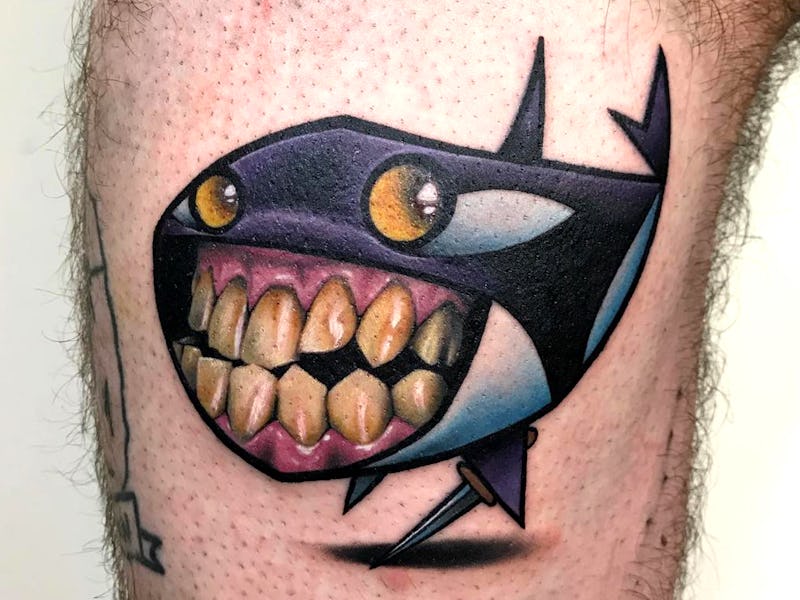Josh Peacock Wants to Tattoo Toothy Critters on Your Body
The artist has found his calling adorning clients with these strange beasts.

Josh Peacock is interested in teeth. The English tattoo artist, born with what he called a “slightly goofy” set of chompers, wrote in an email to Inverse that after getting his straightened, he realized how much his old, crooked smile had reflected his personality.
“We all crave a Hollywood smile but we risk becoming homogenized and sacrificing a small facet of our personality,” he wrote. Plus, “My hearing isn’t the greatest and I found myself subconsciously learning lip read and fixating on teeth a bit.”
So over time, he’s found himself playing with teeth more and more in his work. First as a graffiti artist, and now as a tattoo artist, Peacock’s developed a visual language — most recently expressed in his “critters” — centered in part on strange, toothy smiles.
Peacock’s critters test the boundary between cartoonishness and uncanny realism. Their bodies inhabit a flat, geometric world of primary colors and simple representations, while their mouths open to reveal a hidden, realer-than-real landscape of shining yellowed teeth and wet gums. They invite the viewer to explore each bulge, crack, and cranny in minute detail. Each piece could be a storyboard from a particularly dark episode of The Magic School Bus.
Readers not steeped in tattoo culture might be surprised to learn that there’s a large market for such permanent and shocking artwork. But as Peacock has shared his critters online, he said he’s found some serious demand for these tattoos. Fewer than 20 exist out in the world right now, he wrote, but more are coming soon. (“Can’t wait.”)
“I’m lucky enough to have a hard core of open-minded friends/customers who put their misplaced trust in me,” he wrote, “and the brief usually contains the magic words ‘go crazy,’ and these have been the end result.”
Tattooing, once a fringe and sometimes illicit art form, has found itself fairly suddenly moved to the center of popular conversations about mainstream aesthetics, art, and fashion. Artists routinely build huge followings on Instagram, where it’s not unusual to find their work hawked and shown off by clients like a fancy set of Tommy Choo heels or a new sports car. Famous and beautiful denizens of People Magazine and the late-night talk show circuit, like Cara Delevingne and David Beckham, routinely show off pricey ink. Magazines like GQ and Vanity Fair dish on their inspiration and artistry.
So its possible to understand unsettling ink as a rebuke to that commercialization and normalization — tattoos that your mom and dad, with their matching hearts on their biceps, would still get mad about. Dan Bythewood, of New York Adorned, has made a name for himself escalating the traditional tattooists’ war on polite society, putting out this kind of “#fugly” and questionable art.
Peacock’s not out to upset your parents though. The point of his critters, he wrote, unnerving as they may be, is that they’re fun.
“[The goal is] not so much debasing, more playfulness,” he wrote. “If my tattoos make my clients smile to themselves once a day, then I am a happy man.”
That doesn’t mean the critters don’t have power though. If seeing a set of unbrushed gnashers on someone’s leg makes your gut squirm, you can likely blame a combination of your revulsion for body horror and trypophobia, or fear of clusters of holes in skin.
Neither of these phenomena is particularly well-studied, or make their way into the Diagnostic and Statistical Manual of Mental Disorders, but researchers who have examined the topics think there’s something innate in our biology that makes us squirm at the sight of misplaced bodily features and open holes in skin.
The biologist Ronald Allen Lopez Cruz, writing in the Journal of Popular Film and Television in 2012, suggested that “body horror finds strength in the way it goes against what is considered normal anatomy and function in biological species.”
We fear it, he suspects, for essentially sexual reasons; there’s an evolutionary advantage to revulsion at uncanny, non-adaptive mutations.
Trypophobia is a bit better understood. An experiment published in Psychological Science in 2013 found a relationship between trypophobia-inducing images and revulsion toward poisonous species of frog and spiders. We avoid these images of holes, the research suggests, because eons of evolution have taught us that danger lies there.
If you can move past those feelings, and feel like adorning your body forever with one of Peacock’s strange, adorable critters, it’ll take real commitment.
“They usually take between three to five hours each,” he wrote, “but this also depends on size. I try to use a fairly stripped back palette by removing the background for a higher contrast. The realistic teeth are fairly time consuming but very rewarding too.”
Peacock makes his art at the King Street Tattoo Collective in Cambridge, England. Each critter costs between about £280 and £500 ($360 to $640).